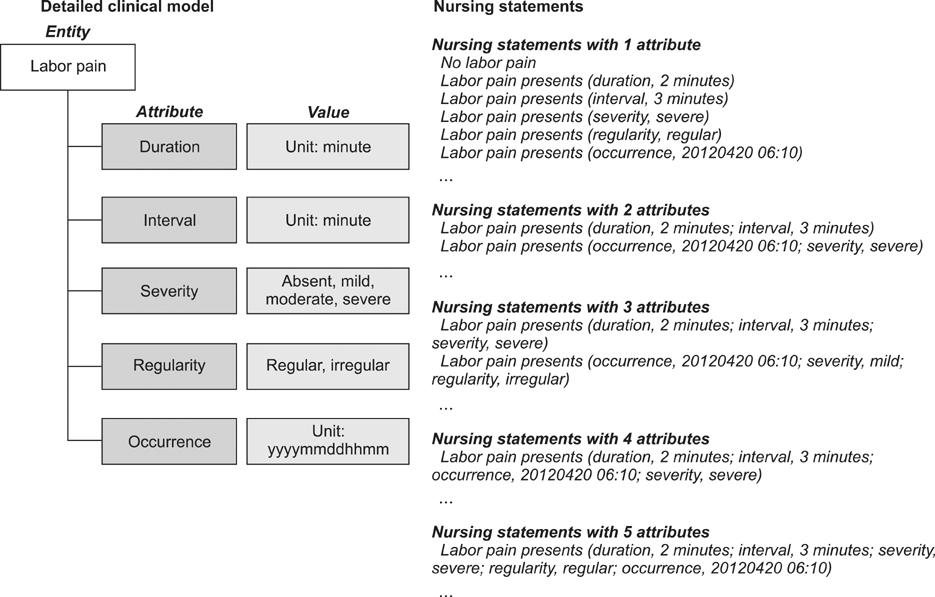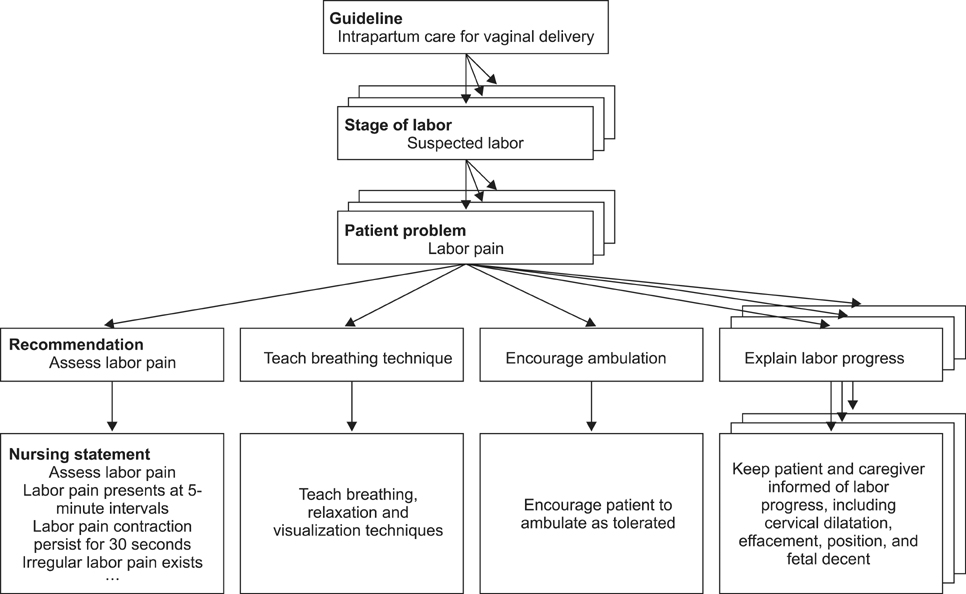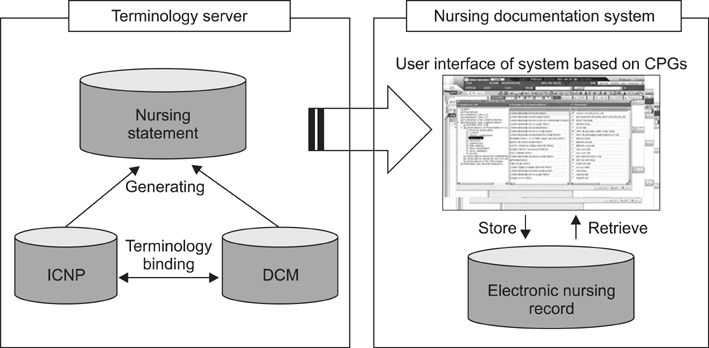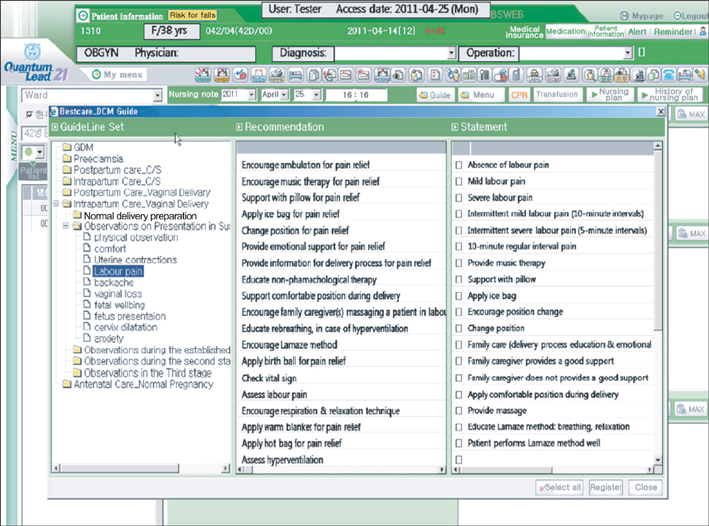Healthc Inform Res.
2012 Jun;18(2):136-144. 10.4258/hir.2012.18.2.136.
Integration of Evidence into a Detailed Clinical Model-based Electronic Nursing Record System
- Affiliations
-
- 1Seoul National University College of Nursing, Seoul, Korea. yulha74@snu.ac.kr
- 2Research Institute of Nursing Science, Seoul National University, Seoul, Korea.
- 3Department of Nursing, Seoul National University Bundang Hospital, Seongnam, Korea.
- KMID: 2045577
- DOI: http://doi.org/10.4258/hir.2012.18.2.136
Abstract
OBJECTIVES
The purpose of this study was to test the feasibility of an electronic nursing record system for perinatal care that is based on detailed clinical models and clinical practice guidelines in perinatal care.
METHODS
This study was carried out in five phases: 1) generating nursing statements using detailed clinical models; 2) identifying the relevant evidence; 3) linking nursing statements with the evidence; 4) developing a prototype electronic nursing record system based on detailed clinical models and clinical practice guidelines; and 5) evaluating the prototype system.
RESULTS
We first generated 799 nursing statements describing nursing assessments, diagnoses, interventions, and outcomes using entities, attributes, and value sets of detailed clinical models for perinatal care which we developed in a previous study. We then extracted 506 recommendations from nine clinical practice guidelines and created sets of nursing statements to be used for nursing documentation by grouping nursing statements according to these recommendations. Finally, we developed and evaluated a prototype electronic nursing record system that can provide nurses with recommendations for nursing practice and sets of nursing statements based on the recommendations for guiding nursing documentation.
CONCLUSIONS
The prototype system was found to be sufficiently complete, relevant, useful, and applicable in terms of content, and easy to use and useful in terms of system user interface. This study has revealed the feasibility of developing such an ENR system.
Keyword
MeSH Terms
Figure
Cited by 1 articles
-
Implementation of a Next-Generation Electronic Nursing Records System Based on Detailed Clinical Models and Integration of Clinical Practice Guidelines
Yul Ha Min, Hyeoun-Ae Park, Eunja Chung, Hyunsook Lee
Healthc Inform Res. 2013;19(4):301-306. doi: 10.4258/hir.2013.19.4.301.
Reference
-
1. Park HA, Cho I, Byeun N. Modeling a terminology-based electronic nursing record system: an object-oriented approach. Int J Med Inform. 2007. 76:735–746.
Article2. Cho I, Park HA, Chung E. Exploring practice variation in preventive pressure-ulcer care using data from a clinical data repository. Int J Med Inform. 2011. 80:47–55.
Article3. Park HA, Cho I, Chung E. Exploring use of a clinical data repository containing international classification for nursing practice-based nursing practice data. Comput Inform Nurs. 2011. 29:419–426.
Article4. International Organization for Standardization. Health informatics: quality criteria and methodology for detailed clinical models. 2009. Geneva, Switzerland: International Organization for Standardization;(ISO/CEN/Working Draft 13972).5. Coyle JF, Mori AR, Huff SM. Standards for detailed clinical models as the basis for medical data exchange and decision support. Int J Med Inform. 2003. 69:157–174.
Article6. Beale T. Archetypes: constraint-based domain models for future-proof information systems. Proceedings of the 11th OOPSLA Workshop on Behavioral Semantics. 2002. 16–32.7. Hovenga E, Garde S, Heard S. Nursing constraint models for electronic health records: a vision for domain knowledge governance. Int J Med Inform. 2005. 74:886–898.
Article8. Garde S, Hovenga E, Buck J, Knaup P. Expressing clinical data sets with openEHR archetypes: a solid basis for ubiquitous computing. Int J Med Inform. 2007. 76:Suppl 3. S334–S341.
Article9. Ahn SJ, Kim Y, Yun JH, Ryu SH, Cho KH, Kim SW, Kwak MS, Yu SJ, Koh YT, Choi DJ. Clinical contents model to ensure semantic interoperability of clinical information. J KIISE Softw Appl. 2010. 37:871–881.10. Goossen W, Goossen-Baremans A, van der Zel M. Detailed clinical models: a review. Healthc Inform Res. 2010. 16:201–214.
Article11. Goossen WT. Using detailed clinical models to bridge the gap between clinicians and HIT. Stud Health Technol Inform. 2008. 141:3–10.12. Kim Y, Park HA. Development and validation of detailed clinical models for nursing problems in perinatal care. App Clin Inform. 2011. 2:225–239.
Article13. Park HA, Min YH, Kim Y, Lee MK, Lee Y. Development of detailed clinical models for nursing assessments and nursing interventions. Healthc Inform Res. 2011. 17:244–252.
Article14. Min YH, Park HA. Development and validation of archetypes for nursing problems in breast cancer patients. J Korean Soc Med Inform. 2009. 15:393–401.
Article15. Lee MK, Park HA. Development of data models for nursing assessment of cancer survivors using concept analysis. Healthc Inform Res. 2011. 17:38–50.
Article16. Kim YR, Park HA, Min YH, Lee MK, Lee YJ. Development of detailed clinical models of nursing information for initial assessment. J Korean Acad Fundam Nurs. 2011. 17:101–112.17. Coopey M, Nix MP, Clancy CM. Translating research into evidence-based nursing practice and evaluating effectiveness. J Nurs Care Qual. 2006. 21:195–202.
Article18. Davies B, Edwards N, Ploeg J, Virani T. Insights about the process and impact of implementing nursing guidelines on delivery of care in hospitals and community settings. BMC Health Serv Res. 2008. 8:29.
Article19. Im EO, Chee W. Evaluation of the decision support computer program for cancer pain management. Oncol Nurs Forum. 2006. 33:977–982.
Article20. Chang SO, Lim SH, Lee SJ, Kim MS. Development of a decision support computer program for pain management in institutionalized patients with dementia. Korean J Fundam Nurs. 2011. 18:116–129.21. Lee NJ, Bakken S. Development of a prototype personal digital assistant-decision support system for the management of adult obesity. Int J Med Inform. 2007. 76:Suppl 2. S281–S292.
Article22. Kim HY, Park HA. Development and evaluation of data entry templates based on the entity-attribute-value model for clinical decision support of pressure ulcer wound management. Int J Med Inform. 2012. 81:485–492.
Article23. Kim EM, Park IS, Shin HJ, Ahn TS, Kim YA, Oh PJ, Woo KS, Jeong EH, Joo YH, Cho EM, Yu OS. The analysis of standard nursing statements at electronic nursing records. J Korean Clin Nurs Res. 2005. 11:149–164.24. Lee I, Park HA. Comparison of nursing records of open heart surgery patients before and after implementation of electronic nursing record. J Korean Soc Med Inform. 2009. 15:83–91.
Article25. Grol R, Grimshaw J. From best evidence to best practice: effective implementation of change in patient's care. Lancet. 2003. 362:1225–1230.
Article26. Ploeg J, Davies B, Edwards N, Gifford W, Miller PE. Factors influencing best-practice guideline implementation: lessons learned from administrators, nursing staff, and project leaders. Worldviews Evid Based Nurs. 2007. 4:210–219.
Article
- Full Text Links
- Actions
-
Cited
- CITED
-
- Close
- Share
- Similar articles
-
- Implementation of a Next-Generation Electronic Nursing Records System Based on Detailed Clinical Models and Integration of Clinical Practice Guidelines
- Comparison of Nursing Records of Open Heart Surgery Patients before and after Implementation of Electronic Nursing Record
- Clinical Nursing Process Model using a Database Linking System
- An Effect of the Application of Educational Electronic Nursing Record System for Nursing Students
- Nurses’ Experiences with the Use of Electronic Nursing Record: A Qualitative Study






